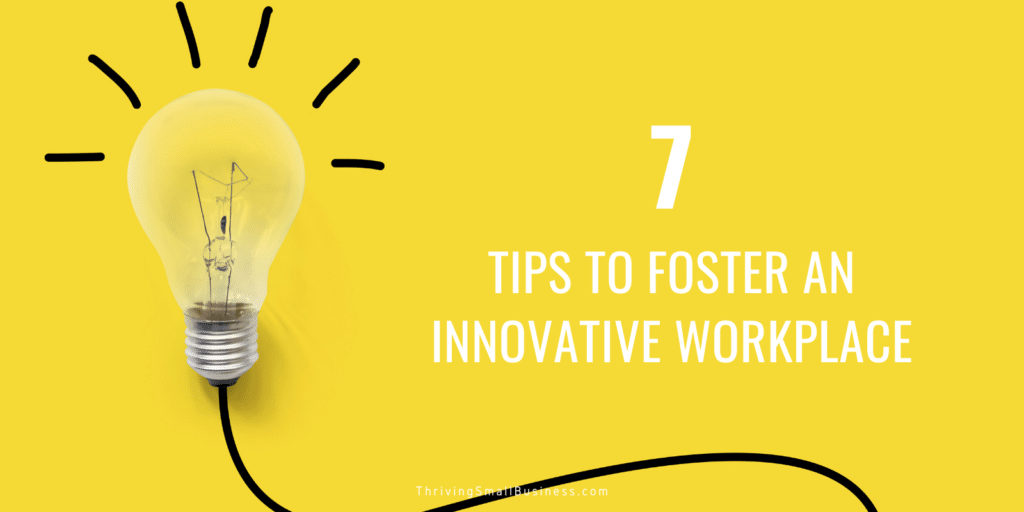7 Tips To Foster And Manage Innovation In Your Office
Estimated reading time: 4 minutes
Innovation is the golden key to success for business.
However, you need to know how to manage innovation to set yourself apart from the rest!
Innovative people have been around since the beginning of time.
These creative doers have literally changed the world.
Without creative and innovative ideas, we would not be where we are today in terms of product development, technology, and the way we deliver service to customers.
Successful organizations have figured out that in order to provide cutting-edge products and services, innovation needs to be incorporated into the way the organization is managed.
7 Tips To Foster An Innovative Workplace
1. Incorporate Innovation Into Business Strategy
Hopefully, your business has a strategic plan.
Within this plan, make sure your Business goals are written specifically to target innovation.
Your strategy should include innovation.
What this means is having goals that focus on creating new systems and processes or improving how business is done.

For instance, if your business has products that are delivered to customers, use your team to come up with innovative ways to enhance the experience, speed up the process, or improve the product.
As an example, I was sitting in a hospital room with a friend when she was being discharged.
A pharmacy tech came to the room, told her she had a prescription for her, and explained that he could either give her the written prescription or he could fill the prescription for her from the hospital pharmacy.
Her co-pay was the same, so of course, she chose to have the prescription filled at the hospital.
This would save a trip to the pharmacy when all she wanted to do was go home and go to bed.
The tech went and got the prescription and delivered it to her room. What a great idea!
2. Develop A Plan For Innovation
I’m always amazed at what can be learned from simply asking customers questions.
This customer feedback is one way to identify new and innovative ideas.
Customers have all kinds of ideas that can be utilized to develop systems and processes to enhance the customer experience.
Analyze this data and turn it into improvement plans.
Just remember, if you are not going to do something with what you learn from asking customers the question, then don’t even bother asking.
Businesses also use customer complaints to get ideas for new innovative products or services.
For example, if your customers complain about wait times, look for new or innovative ways to be timely in delivering products or services.
3. Hire Creative People
Creative people think outside the box. Make sure you have a good mix of all social styles on your employment team.
There are several social style testing models that can be given to potential job candidates that help identify people with strengths in creativity.
One that I am familiar with is DISC assessments.
These assessments can help organizations and employees get a better understanding of natural strengths.
Creative people are who you want to add to a team to help you brainstorm innovation and think outside the box.
When employees are matched with tasks that complement their natural abilities, an organization can progress at a much quicker pace.
4. Create Environments That Foster Innovation.
Workspaces and physical environments can foster creative energy.
Design workspaces that inspire creative thinking.
As an example, someone who enjoys doing accounting work may be perfectly content in a cubicle with fluorescent lights and minimal noise.
However, someone who is creative by nature may find a more relaxed atmosphere with bold-colored walls, soft lighting, and music important to generating innovative ideas.
5. Incorporate Think Time Into Schedule
We all get busy. Be intentional with the work schedule and carve out a percentage of time for thinking.
Take time to think, dream, and wonder about what if. Use this time to imagine the possibility of a new normal.
For instance, designate 4 hours a week out of a 40-hour week (10%) to foster creative thought.
6. Manage Creative People.
Managing creative people is very different than managing other social styles.
Creative people need more flexibility and don’t perform as well in rigid, structured environments.
Managers need to be sensitive to the special needs of this group and develop systems to support the innovative process.
For instance, you may want to allow creatives to influence their work space by offering ideas of what the optimal work environment would be to help them think creatively.
7. Reward Innovation.
Innovation should be rewarded.
Create a reward system for employees who come up with creative and innovative ideas to solve problems and improve services or internal work processes.
Finally, organizations that innovate and are successful with the management of innovation quickly become the dividing line between successful and mediocre companies. Incorporate innovation into business strategy to help foster business development and growth.






